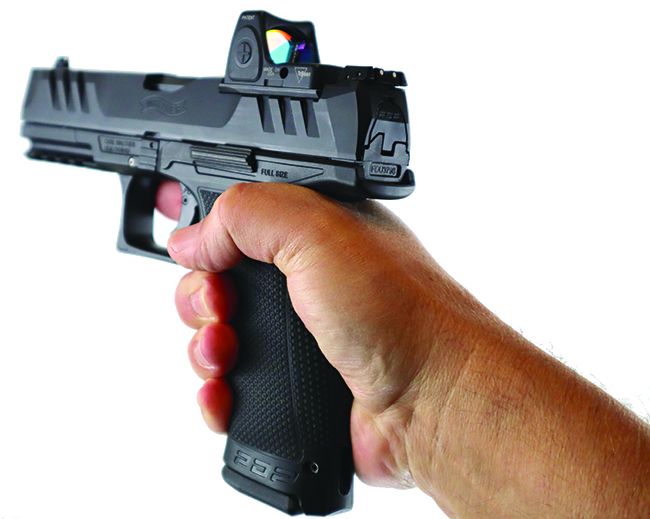Nearly every new 9mm pistol has the slide cut for an optic. While an optic-ready slide is the natural progression for new striker-fire pistols, older platforms are also being adapted to accept a red dot. Take, for instance, the Beretta Model 92 series, a classic double-stack 9mm, which is now available in an optic-ready variant, or the 1911 platform, which is now more frequently being adapted to carry a red dot. Some manufacturers have morphed the platform to accept double-stack magazines, literally doubling the round count in 9mm guns, and called them 2011s. An excellent representation of the diversity in double-stack 9mm pistols that are optic-ready is seen in the Beretta 92X Performance Carry Optic, Springfield Armory Prodigy 4.25, Walther PDP Full Size 4.5, and Glock’s G47 MOS.
We would take any one of these guns in a New York minute, but it would be a tough decision if we had to choose just one. On one hand, there is the simplicity of a striker-fire pistol like the Walther or the Glock, or the crisp 1911-style trigger of the Springfield, or the versatility of the Beretta’s double-action/single-action trigger. Perhaps a heavier gun to help stifle recoil, or a lighter gun for more comfortable concealed carry is the better option? Those were some of the questions we asked when evaluating these excellent pistols, as well as the usual parameters of performance, reliability, accuracy, and ease of use.
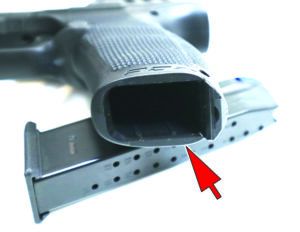
Because these are all optic-ready pistols, we tested four different red dot reflex sights on them. The optics were judged on clarity of the red dot, size of the red dot, brightness adjustment, ease of battery maintenance, ability to co-witness with iron sights, ease of use, and ruggedness. Yes, we dropped expensive pistols with expensive red dots in the dirt so you don’t have to. We also used the red-dot sight as impromptu cocking levers with our hands, on the edge of a shooting bench, and the mouth of a Kydex holster. Front slide serrations are important when a red dot is mounted on these pistols because the optic gets in the way of a traditional pinch-style slide rack where your support hand palms the top of the slide and you pinch the slide between your thumb and index finger to pull back the slide.
The four red-dot sights were an Ameriglo Haven Carry Ready Combo, $329; a Crimson Trace CTS-1250, $230; Steiner’s MPS, $499; and Trijicon’s RMR Type 2, $479. We ranked each pistol on its own merits separate from the red dots. Accordingly, the heights and weights for the handguns don’t reflect the presence of the red dots. But we did pair each gun with a single dot sight for extensive action and accuracy shooting. The red dots offered enough extra precision off the bench that we reported only the accuracy data with each sight aboard. The red-dot grades are listed in the same modules as the pistols they were primarily used on.
How We Tested
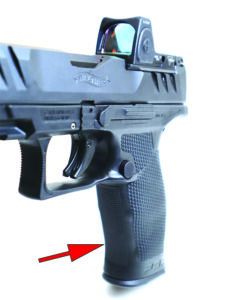
We tested the guns/red dots for speed on plain cardboard IPSC/USPSA targets (78 cents each from shop.actiontarget.com) performing the Failure Drill or Mozambique Drill, depending on how politically correct you are. Red dots make aiming much easier than aligning traditional sights, but finding the red dot can be liability, especially in bright light conditions. All the more reason to install co-witnessed iron sights. For accuracy testing at 25 yards, we used Thompson Targets TAC (Training with Audible Cue) targets ($8 per five-pack from ThompsonTarget.com). These targets can be used with a partner who cues the shooter on what part of the target to fire at. The idea with TAC targets is to train the shooter to process commands and make decisions quickly. Scores can be calculated so you can chart your progress and train smart or have bragging rights for the day.
We used both training ammo and defense ammo, with different bullet weights and types. Training rounds consisted of Winchester Active Duty and Federal American Eagle, both loaded with 115-grain FMJ bullets. Defense loads included Remington HTP with 147-grain JHP bullets and SIG V-Crown with 124-grain JHPs. After tabulating the range data, we discovered the Walther had the highest muzzle velocities and the Beretta the lowest, with an average difference of 58 fps. The Springfield and Glock had muzzle velocities in between the two. We also found more differences. For one thing, the triggers on all four were very different, but one gun stood out as our favorite. Here’s what we thought about each gun in more detail.
Walther PDP Full Size 4.5 2842475 9mm Luger, $650
Gun Tests grade: A
Trijicon RMR Type 2 RM01-C-700600, $479
Gun Tests grade: A
The Walther PDP (Performance Duty Pistol) series was introduced in 2021 and replaces the PPQ series. Like the Glock, it is a striker-fire recoil-operated pistol with a polymer frame and takes modularity to another level. With the PDP series, full- and compact-size frames are compatible with three different slide and barrel lengths. So you can mix and match the slides and frames. Our test sample had a 4.5-inch slide and barrel on a full-size frame. All pistols uses the exact same recoil assembly.
| Action Type | Semi-auto, short-recoil-operated |
| Trigger Type | Striker fire |
| Overall Length | 8.0 in. |
| Overall Height | 5.7 in. |
| Maximum Width | 1.3 in. |
| Weight Unloaded | 25.4 oz. |
| Weight Loaded | 33.1 oz. |
| Barrel Length/Twist | 4.5 in.; 1:10 |
| Capacity | 18+1 |
| Slide | Black, steel |
| Slide Retraction Effort | 16.0 lbs. |
| Frame | Polymer |
| Frame Front Strap Height | 2.6 in. |
| Frame Back Strap Height | 3.8 in. |
| Grips | Textured, 3 modular back straps |
| Grip Thickness Maximum | 1.3 in. |
| Grip Circumference Maximum* | 5.5 in. |
| Front Sight | White dot |
| Rear Sight | Adjustable, two white dots |
| Trigger Pull Weight | 4.6 lbs. |
| Trigger Span | 2.8 in. |
| Magazines | (2) double stack; steel w/polymer base pads |
| Safety | Firing pin block; trigger safety lever |
| Warranty | Limited lifetime |
| Telephone | (479) 242-8500 |
| Website | WaltherArms.com |
| Made In | Germany |
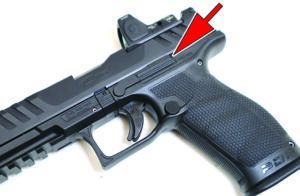
In the hard case are two magazines, a magazine reloader, and two back straps. The optics mounting plate is free from Walther, but you have to go online (WaltherArms.com/optic-plate-request) to order it. The online form asks a few questions about your type of Walther pistol and what red-dot sight you will be using. Walther then ships the plate to you free of charge.
The optics cut in the PDP slide is deeper than the cut on the other pistols, which means the sight sits lower, and depending on the red-dot optic you use, you may not need to install tall sights. With the Trijicon RMR mounted, however, tall sights were needed. If you do need to swap sights, the PDP is compatible with Glock aftermarket sights, so you will have a lot of different options.
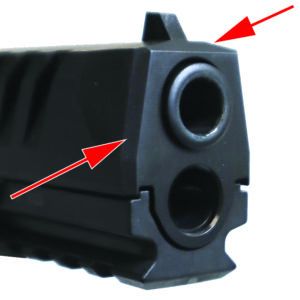
The Trijicon RMR uses a 3.25-moa dot, which is a good size for defense work and competition shooting. Fast at close range, it does not obscure the target at 25 yards. There was no flaring of the dot. The RMR is battle and street tested and is a benchmark for red-dot reflex sights. The sight needs to be removed when changing the battery, and that is a pain. We have used this sight on other guns and found you do need to check zero after changing the battery.
Buttons on the sides of the RMR allow the user to adjust the illumination brightness, toggle between manual and automatic modes, and turn off the sight. In automatic mode, the sight automatically adjusts the brightness of the dot based on lighting conditions. In manual mode, the sight will remain in manual mode for 16.5 hours following the last push of a button. After which, the sight will default to the automatic mode and turn on once it detects movement. Elevation and windage screws can be adjusted using the rim of a 9mm cartridge case, and the direction is clearly marked.
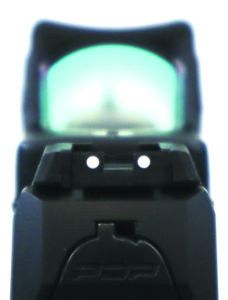
The grip is what you immediately notice with the PDP. It is what Walther calls Red Dot Ergonomics. A slight forward sweep on the front grip strap, where your small finger grasps the grip, slightly lowers the muzzle as you grip the pistol so it is easier to pick up the dot when aiming. We thought it was only marketing hype, but in use it actually works to get your eye on the dot faster. The grip texture is aggressive and does not catch on clothing or chew on your hand. There are slight palm swells in the grip sides so your palm makes near total contact with the grip. The grip feels excellent in hand. We used the medium-size back grip strap during the evaluation in lieu of the small or large back strap with a beavertail. The trigger guard is also undercut to get a higher grip for better recoil management.
The ambi slide stop is long and large. A few shooters accidentally rode the slide stop, causing the slide not to lock back on the last round fired. It was user error and a matter of pointing the shooting-hand thumb forward, not up, like when you ride the thumb safety on a 1911. The magazine-release button is round, big, and checkered, so dumping an empty magazine is fast. The magazine button can also be swapped for a left-hand shooter.
The slide has coarse serrations forward and aft that Walther describes as SuperTerrain Serrations that protrude from the slide rather than are cut into the slide. The slide is machined so the serrations do protrude and offers excellent grasping points when racking the slide or doing a press check.
The three-dot sights are nothing special, but the rear sight is completely adjustable in the event you want to run the PDP without an optic. The most noticeable feature with the PDP is the PDT (Performance Duty Trigger) trigger. It has a shorter and lighter take up, a more distinct wall, and a tactile feel as the trigger breaks at 4.6 pounds on average. The reset is quick and a lot less than the Glock. This is an excellent striker-fire trigger and is a lot better than some aftermarket triggers we have tested.
In accuracy testing, the PDP’s best group with Remington HTP defense ammo measured 1.12 inches. With SIG defense ammo, the smallest group measured 1.56 inches. Moving to the training ammo, the Winchester Active Duty measured 1.39 inches. Federal American eagle measured 1.79 inches. On average across all ammos, the pistol shot 1.7-inch groups. The red dot and the trigger helped us attain these impressive results.
In the speed drill there was some muzzle flip, but the grip helped us to manage recoil, and the exceptional trigger allowed us to fire two very quick shots to center of mass and then a surgical shot to the head. This is a forgiving gun that allows the user to shoot better and more accurately as well as faster.
Our Team Said: The PDP is an excellent pistol. Grip, trigger, and accuracy are excellent. We were surprised at how easily we adapted to this pistol and how well we were able to shoot it. We liked the 18-round flush-fit magazine. The price versus performance of this pistol makes it a Best Buy. The Trijicon RMR Type 2 cost twice as much as the other sights, but it is worth it, in our view. We like the features of the RMR, especially the automatic dot brightness and manual modes, and it turned on when sensing motion. The dot was pin-point crisp and worked well in all lighting conditions.
9mm Luger Range Data
To collect accuracy data, we fired five-shot groups from a bench using a rest. Distance: 25 yards with the reflex red dot sights. We recorded velocities using a ProChrono digital chronograph set 15 feet from the muzzles.| Federal American Eagle 115-grain FMJ | Beretta 92X | Glock G47 MOS | Springfield Armory Prodigy 4.25 | Walther PDP 4.5 |
| Average Velocity | 1135 fps | 1136 fps | 1140 fps | 1150 fps |
| Muzzle Energy | 329 ft.-lbs. | 330 ft.-lbs. | 332 ft.-lbs. | 338 ft.-lbs. |
| Smallest Group | 1.48 in. | 1.68 in. | 0.70 in. | 1.76 in. |
| Average Group | 1.59 in. | 1.88 in. | 1.02 in. | 1.98 in. |
| Winchester Active Duty 115-grain Ball | Beretta 92X | Glock G47 MOS | Springfield Armory Prodigy 4.25 | Walther PDP 4.5 |
| Average Velocity | 1220 fps | 1257 fps | 1229 fps | 1289 fps |
| Muzzle Energy | 380 ft.-lbs. | 404 ft.-lbs. | 386 ft.-lbs. | 424 ft.-lbs. |
| Smallest Group | 1.40 in. | 1.49 in. | 1.02 in. | 1.39 in. |
| Average Group | 1.44 in. | 1.54 in. | 1.06 in. | 1.45 in. |
| SIG V-Crown 124-grain JHP | Beretta 92X | Glock G47 MOS | Springfield Armory Prodigy 4.25 | Walther PDP 4.5 |
| Average Velocity | 1023 fps | 1051 fps | 1031 fps | 1116 fps |
| Muzzle Energy | 288 ft.-lbs. | 304 ft.-lbs. | 293 ft.-lbs. | 343 ft.-lbs. |
| Smallest Group | 2.10 in. | 2.04 in. | 0.97 in. | 1.56 in. |
| Average Group | 2.30 in. | 2.72 in. | 1.20 in. | 1.78 in. |
| Remington HTP 147-grain JHP | Beretta 92X | Glock G47 MOS | Springfield Armory Prodigy 4.25 | Walther PDP 4.5 |
| Average Velocity | 921 fps | 920 fps | 925 fps | 976 fps |
| Muzzle Energy | 277 ft.-lbs. | 276 ft.-lbs. | 279 ft.-lbs. | 311 ft.-lbs. |
| Smallest Group | 1.94 in. | 2.09 in. | 1.10 in. | 1.12 in. |
| Average Group | 1.97 in. | 2.38 in. | 1.27 in. | 1.26 in. |

























